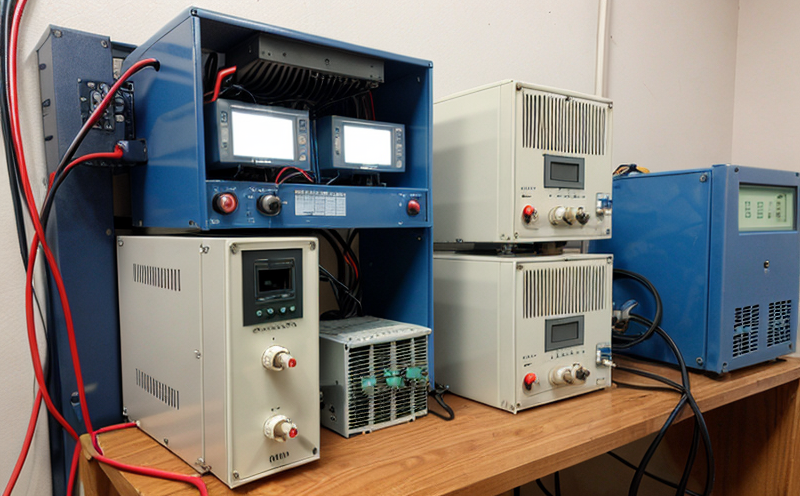EN 50328 Validation Testing of Traction Inverters
The validation testing of traction inverters according to EN 50328:2017, is a critical process in the railway and transportation sector. This European standard ensures that electrical systems, including traction inverters, meet stringent safety, performance, and environmental requirements. Traction inverters play a pivotal role in converting DC power from the overhead lines or batteries into AC power for driving the motors of electric locomotives.
The testing process involves multiple stages aimed at ensuring compliance with the specified standards. The first step is to prepare the traction inverter for testing by connecting it to a test bench that simulates real-world operating conditions. This includes providing the inverter with various input voltages and currents, which mimic those found on electric railways.
The EN 50328 standard sets out specific acceptance criteria that must be met during these tests. These include but are not limited to efficiency under different load conditions, harmonic distortion, and electromagnetic interference (EMI) levels. The testing process also evaluates the inverter's ability to withstand specified environmental stresses such as temperature variations, humidity, and altitude.
During the validation process, various instruments and equipment are used to monitor parameters like voltage, current, frequency, power factor, and EMI emissions. These measurements provide a comprehensive view of the inverter’s performance under different operating conditions. The results of these tests are then compared against the criteria outlined in EN 50328:2017 to determine compliance.
It is important to note that this testing process goes beyond mere compliance; it ensures the reliability and safety of railway traction systems, which have a direct impact on passenger and cargo transportation. The rigorous nature of these tests helps identify potential issues early in the development cycle, allowing for necessary adjustments before mass production begins.
EN 50328 validation testing is not just a regulatory requirement but also an essential step in ensuring that traction inverters perform reliably under various operating conditions. By adhering to this standard, manufacturers can demonstrate their commitment to quality and safety, which is crucial for gaining market acceptance and maintaining compliance with international regulations.
In conclusion, the EN 50328 validation testing of traction inverters is a vital process that ensures the reliability and safety of electric railway systems. This testing not only meets regulatory requirements but also enhances the overall performance and efficiency of these critical components.
Why It Matters
The importance of EN 50328 validation testing cannot be overstated, especially in the context of railway and transportation systems. These tests are crucial for several reasons:
Ensures compliance with international standards: The standard provides a framework that aligns with global best practices.
Enhances reliability: By simulating real-world conditions, these tests help identify potential issues early in the development process.
Maintains safety: Compliance ensures that traction inverters operate safely and efficiently under various environmental conditions.
Improves efficiency: Testing helps optimize performance parameters such as energy consumption and power output.
The successful completion of these tests is a testament to the quality and reliability of the product, which in turn fosters trust among stakeholders including regulators, operators, and passengers. This trust is essential for maintaining high standards in the railway industry.
Applied Standards
| Standard | Description |
|---|---|
| EN 50328:2017 | This standard specifies the requirements for the design, construction, and testing of traction inverters used in railway applications. |
| EN 50328-1:2017 | This part specifies the general requirements for the design, construction, and testing of traction inverters. |
| EN 50328-2:2017 | This part specifies the requirements for the electrical design of traction inverters. |
| EN 50328-3:2017 | This part specifies the requirements for the mechanical design and construction of traction inverters. |
The application of these standards ensures that all aspects of the traction inverter are thoroughly evaluated, from its electrical characteristics to its mechanical robustness. This comprehensive approach guarantees a high level of quality and reliability.
Benefits
Ensures compliance with international regulations
Improves product reliability through rigorous testing
Maintains safety in railway operations
Enhances efficiency and reduces operational costs
Builds trust among stakeholders, including passengers and regulators
Facilitates easier market entry for compliant products
Achieves higher product quality through continuous improvement
Promotes innovation by identifying areas for enhancement
The benefits of adhering to EN 50328 are manifold, ranging from regulatory compliance to improved operational efficiency. By implementing these tests, manufacturers can ensure that their products meet the highest standards of quality and reliability.





